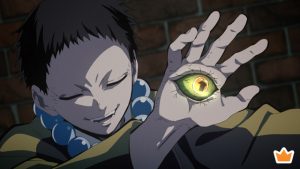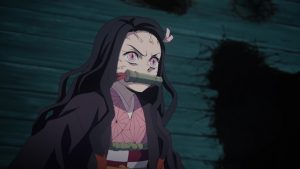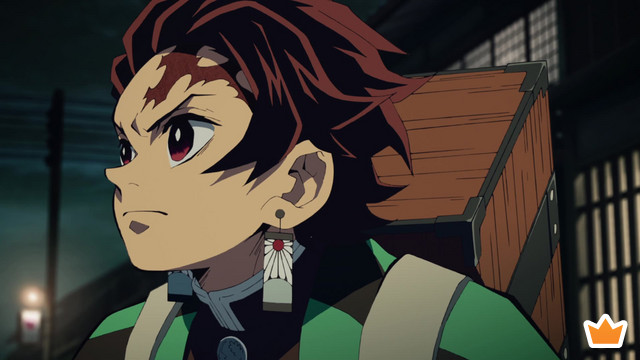
The myriad battle manga of Weekly Shonen Jump tend to follow a fairly consistent basic structure, and that’s okay because what separates the Busou Renkins from the Yu Yu Hakushos has always been execution rather than the premise. We’ve seen this apply to adaptations of these stories as well, with the execution of their anime making or breaking the material’s reputation (poor Black Clover). Different shows have their own strengths and weaknesses, of course, but this season’s Kimetsu no Yaiba stands out because of the way it paces its story and we’re about to find out why.
The Opening
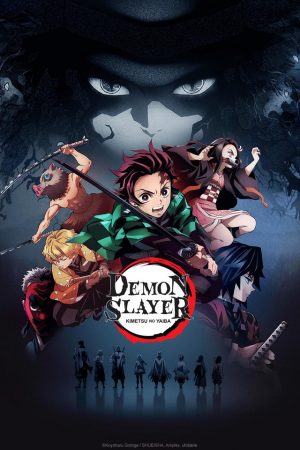
This show knows you’ve seen its brand of setup before so it doesn’t drag its feet as it gets going, but it also remembers the need to add context to create audience investment. We do see our hero Tanjiro enjoying his peaceful life with his family and heading into town to sell firewood. It’s obvious to anyone who has experienced this sort of plot before that these side characters are all going to be dead in the immediate future and the show even acknowledges this by opening on the aftermath, so it goes through the motions quickly. Exchanges are only a few sentences long, and characters exit scenes just as quickly as they enter. It’s not that the show doesn’t care about its setup, it’s that it knows how to use it economically.
Like with any TV show, Kimetsu no Yaiba’s episodes are on a very strict time limit and it needs to use that time concisely without detracting from the narrative. This is where the beauty of the first episode’s pacing lies, as every last second of this opening act serves a clear purpose. The scene at Tanjiro’s home establishes his relationship with each of his family members through a small handful of well-chosen words, before cutting to him in town selling his firewood despite the less favorable conditions, where we learn about his commitment to his work, that his helpful attitude extends to strangers instead of being limited to his family and that he has a powerful sense of smell.
The scene between Tanjiro and the old man who offers him shelter for the night slightly breaks the flow by spending a bit too long on them arguing about the safety of mountain travel at night, but this at least still establishes the presence of demon hunters and demons before we meet them in a more personal capacity.
The Inciting Incident
Of course, Tanjiro’s family is murdered by demons before he gets back, leaving only his sister Nezuko alive as a bloodthirsty demon. The reveal of this metamorphosis is the first time we see the show slow down a little, and rightfully so, as the complex feelings Tanjiro has at seeing his now demonic sister trying to eat him is an important moment for his characterization and takes longer to fully explore.
But the show is still committed to not letting a single scene outstay its welcome and quickly introduces demon hunter Giyu Tomioka for Tanjiro to fight over Nezuko’s fate with. The battle isn't especially notable for its action but makes up for that by condensing heaps of character information into every blow. In only a few minutes the show makes us feel Tanjiro’s unconditional love for his sister, his desire to protect her even when she’s trying to kill him, his unflinching hope to cure her of her ailment despite knowing there’s nothing to suggest that’s even possible and the way he uses resourceful combat strategies to outsmart his opponent while also maintaining the desperate charge into certain defeat of an amateur.
And don’t even get us started on all the development this scene gives Giyu. Whereas other shonen drag their story out with inconsequential battles, Kimetsu no Yaiba uses its fights to build its cast without interrupting its quick pace.
Pacing and Nezuko
With all of that out of the way in only a single episode, the rest of the show can dedicate itself to Tanjiro’s quest to protect and eventually cure Nezuko while she follows him as a now-pacified demon. This is where a lesser show would have suffered because of a quick pace, by only giving our female lead enough time to be established as an apple in the eye of the protagonist rather than a real character, but Kimetsu no Yaiba knows how to handle its speed well and allowed some quick character building moments that are integral to making Nezuko feel like an authentic inhabitant of the story’s world.
We quickly see her as being a caretaker to the other children as a human during the opening and we see her choose to fight her urges as a demon when she protects an unconscious Tanjiro from Giyu, motivating the latter to recruit the former as a demon hunter, which forms the crux of the story. Of course, these are quick moments since the story needs to keep moving quickly, but they’re enough to make Nezuko an active agent within the story and letting us get to know her through her actions.
It may be somewhat contentious then, for the show to greatly reduce Nezuko’s role in some of the following episodes by having her generally just sit in a basket carried by Tanjiro before eventually going into a coma. However, the problem with pure-hearted side characters like Nezuko whose role is to motivate the hero is that they start feeling like Mary Sues if given too much screen time. The best ways to mitigate this is to either start introducing character flaws to ground them like with Trisha Elric, or show very little of them like with Kamina’s father, and the latter is much more compatible with the type of fast pace Yaiba employs, so its use of it is instrumental in preserving its precise use of running time economy.
Final Thoughts
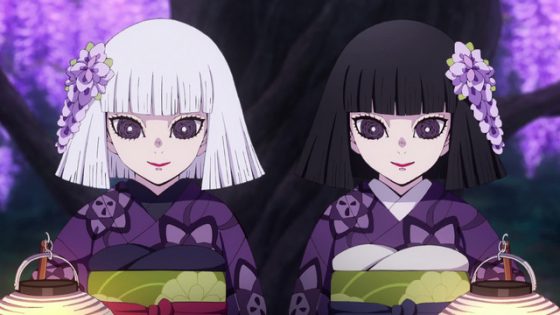
Kimetsu no Yaiba does much more to keep its pace on-point such as the way its training arc frequently switches between full-scenes and montages depending on what’s most pertinent to the story and the way it uses visual metaphors such as its famous string as a shorthand for Tanjiro’s swordsmanship skills, but we just wanted to give a quick showcase as to how the show’s good pacing helps the story. Be sure to let us know what you think of Kimetsu no Yaiba’s pace in the comments and let us know what scenes you wish would have been longer or shorter.
Recommended Post
Demon Slayer: Kimetsu no Yaiba Drops New PV!
Recommended Post



